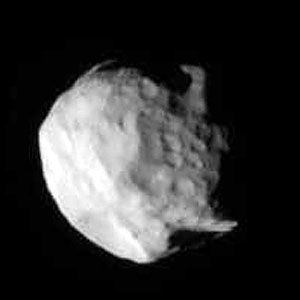Helene (moon) facts for kids

Helene is a small moon that orbits the giant ringed planet Saturn. It is one of Saturn's many moons, and it has a special relationship with a much larger moon named Dione. Helene shares Dione's orbit around Saturn. It travels about 60 degrees ahead of Dione, almost like a cosmic escort! Helene was first spotted in 1980 by astronomers using telescopes on Earth.
Contents
Discovering Helene: A Look Back
Helene was discovered on March 1, 1980. It was found by a team of astronomers named Pierre Laques and Jean Lecacheux. They used observations made from the Pic du Midi Observatory in France. At first, it was given the temporary name S/1980 S 6. Later, it was officially named Helene, after a character from Greek mythology. Helene was the granddaughter of Uranus and Gaia, and the sister of the Titans.
Helene's Unique Orbit Around Saturn
Helene is known as a "trojan moon." This means it shares an orbit with a larger celestial body. In Helene's case, it shares its path with Dione. Helene orbits Saturn at a special point called a Lagrange point. These are places in space where the gravity of two large objects (like Saturn and Dione) balances out. This allows a smaller object, like Helene, to stay in a stable position.
Lagrange Points Explained
Imagine Saturn and Dione pulling on Helene with their gravity. At the L4 Lagrange point, where Helene is, these pulls cancel each other out. This keeps Helene "stuck" in a stable spot. It's like a perfect parking spot in space! Helene is located at Dione's L4 point. This means it is 60 degrees ahead of Dione in their shared orbit. There is another moon, Polydeuces, which is a trojan moon of Dione as well. Polydeuces is located at Dione's L5 point, 60 degrees behind Dione.
What Helene Looks Like
Helene is a very small moon. It is shaped somewhat irregularly, not perfectly round like Earth's Moon. Its average diameter is about 36 kilometers (22 miles). This makes it much smaller than Dione, which is about 1,123 kilometers (698 miles) across. Because of its small size, Helene does not have enough gravity to pull itself into a perfect sphere.
Helene's Surface Features
Scientists have studied Helene's surface using spacecraft like Cassini. The surface of Helene appears to be quite bright. It is likely covered in ice, similar to many other moons of Saturn. The surface also has some craters from impacts by space rocks. These craters show that Helene has been hit many times over billions of years.
Exploring Saturn's Moons with Cassini
The Cassini spacecraft was a very important mission to Saturn. It orbited Saturn for many years, from 2004 to 2017. Cassini took amazing pictures and gathered lots of data about Saturn and its moons, including Helene. The image at the top of this article was taken by Cassini. Missions like Cassini help us learn more about our Solar System and the incredible objects within it.
Images for kids
See also
 In Spanish: Helena (satélite) para niños
In Spanish: Helena (satélite) para niños


